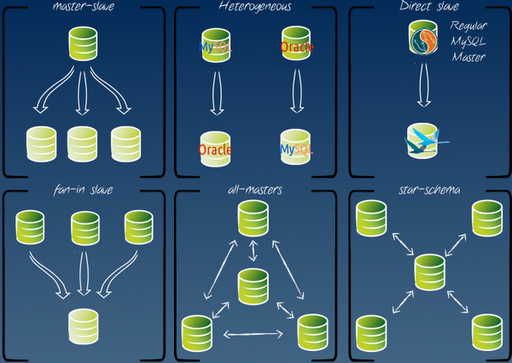Data replication from MySQL to MongoDB
- Tutorial

There are times when you need to change the system architecture on the go. Perhaps you found a bottleneck in your project or decided that at the current growth rate, difficulties with scaling or fault tolerance may soon arise. Just for such cases there is a Tungsten Replicator.
Tungsten Replicator is a free, open-source, Java-based application that extends MySQL database replication functionality. Tungsten's capabilities are wide, including multi-master replication, parallel replication, heterogeneous data replication between MySQL and Oracle, PostgreSQL, MongoDB. In this article, heterogeneous replication of the MySQL wizard with a subordinate MongoDB server will be considered, CentOS 6.5 will act as the OS.
Dependency Installation
Since Tungsten Replicator is written in java, at least you will need to install OpenJDK 1.6 or Oracle Java 6. Also, some of the scripts are written in ruby, so it will also need to be installed (version => 1.8) if you do not already have it:
# yum install java-1.6.0-openjdk rubyInstall MySQL
If MySQL You already have Server installed, you only need to tweak its configuration, as described below, and get the user to replicate.
If MySQL is not already installed, click here.
Connect the necessary repositories:
Install MySQL Server 5.5:
Adjust the MySQL configuration for replication needs:
We activate the automatic start of MySQL at system startup and start the service:
Run the initial MySQL installation script and set the password for root.
For replication, it is desirable to have a separate user:
# rpm -Uvh download.fedoraproject.org/pub/epel/6/x86_64/epel-release-6-8.noarch.rpm# rpm -Uvh rpms.famillecollet.com/enterprise/remi-release-6.rpmInstall MySQL Server 5.5:
# yum --enablerepo=remi install mysql mysql-serverAdjust the MySQL configuration for replication needs:
# vim /etc/my.cnf…
# Назначаем сервер “Мастером”
server-id = 1
# Куда писать бинарный лог
log_bin = /var/log/mysql/mysql-bin.log
expire_logs_days = 10
# Для реликации с MongoDB обязательно выставлять формат бинарного лога в “ROW”
binlog_format = ROW
# Максимальный размер файла лога
max_binlog_size = 256M
# Частота синхронизации операций из бинарного лога с диском
sync_binlog = 1
...
We activate the automatic start of MySQL at system startup and start the service:
# chkconfig --level 35 mysqld on# service mysqld startRun the initial MySQL installation script and set the password for root.
# mysql_secure_installationEnter current password for root (enter for none):
Change the root password? [Y/n] y
New password: SomeSecretPasswD
Re-enter new password: SomeSecretPasswD
Remove anonymous users? [Y/n] y
Disallow root login remotely? [Y/n] y
Remove test database and access to it? [Y/n] y
Reload privilege tables now? [Y/n] y
For replication, it is desirable to have a separate user:
# mysql -u root -p# mysql > grant all on *.* to tungsten identified by 'password' with grant option;Query OK, 0 rows affected (0.01 sec)Installing MongoDB
If you already have MongoDB, you can proceed to the next step.
If not, Mongo installation instructions are here.
Connect the MongoDB repository:
And install the MongoDB Server 2.4 packages:
Activate the automatic launch of MongoDB, when the system boots up and start the service:
To check the service’s health, look at the list of databases:
By default, authorization is not required.
# vim /etc/yum.repos.d/mongodb.repo[mongodb]
name=MongoDB Repository
baseurl=http://downloads-distro.mongodb.org/repo/redhat/os/x86_64/
gpgcheck=0
enabled=1
And install the MongoDB Server 2.4 packages:
# yum install mongo-10gen mongo-10gen-serverActivate the automatic launch of MongoDB, when the system boots up and start the service:
# chkconfig --level 35 mongodb on# service mongodb startTo check the service’s health, look at the list of databases:
# mongoMongoDB shell version: 2.4.3connecting to: test> show dbslocal 0.078125GBBy default, authorization is not required.
Installing the master replicator for MySQL The
current, at the time of writing, version of the replicator is located at this link.
To begin with, we will
# cd /opt# mkdir replicator# cd replicator# mkdir mysql # Здесь мы разместим репликатор для мастер-ноды# mkdir mongodb # Здесь будет репликатор для слейваcreate several directories for our replicator, for example, in / opt: Download the archive with the replicator in the current directory:
# wget tungsten-replicator.googlecode.com/files/tungsten-replicator-2.2.0-292.tar.gz# tar -xzf tungsten-replicator-2.2.0-292.tar.gz# mv tungsten-replicator-2.2.0-292/ tungsten-replicator/Now, prepare the installation script for the master replicator:
# vim master-installer.shcd /opt/replicator/tungsten-replicator
./tools/tungsten-installer --master-slave -a \
--datasource-type=mysql \
--master-host=127.0.0.1 \
--datasource-user=tungsten \
--datasource-password=password \
--datasource-mysql-conf=/etc/my.cnf
--datasource-log-directory=/var/log/mysql/
--datasource-port=3306 \
--service-name=mongodb \
--home-directory=/opt/replicator/mysql \
--cluster-hosts=127.0.0.1 \
--thl-port=10001 \
--rmi-port=11001 \
--java-file-encoding=UTF8 \
--mysql-use-bytes-for-string=false \
--mysql-enable-enumtostring=true \
--mysql-enable-settostring=true \
--svc-extractor-filters=colnames,pkey \
--svc-parallelization-type=none --start-and-report
In this configuration everything will be replicated, i.e. each base along with all tables.
If you need to replicate strictly defined tables, you can immediately identify the filter by replacing the penultimate line (svc-extractor-filters) in the script with:
--svc-extractor-filters=replicate \
"--property=replicator.filter.replicate.do=db1.table1,db2.table2,dbN.tableN" \
Everything is ready for the wizard, we can run the installation script:
# sh master-installer.shINFO >> 127_0_0_1 >> Getting services listThe wizard is ready, now you can connect one or more slaves to it - MySQL or PostgreSQL for example. But our goal is replication with MongoDB, let's move on to it.
INFO >> 127_0_0_1 >> ...
Processing services command ...
NAME VALUE
- - appliedLastSeqno: 0
appliedLatency: 1.218
role: master
serviceName: mongodb
serviceType: local
started: true
state: ONLINE
Finished services command ...
Installing a slave replicator for MongoDB We will
prepare a script for installing a slave replicator that will pump data into MongoDB.
# vim slave-installer.shcd /opt/replicator/tungsten-replicator
tools/tungsten-installer --master-slave -a \
--datasource-type=mongodb \
--master-host=127.0.0.1 \
--service-name=mongodb \
--home-directory=/opt/replicator/mongodb \
--cluster-hosts=127.0.0.1 \
--datasource-port=27017 \
--master-thl-port=10001 \
--thl-port=10002 \
--rmi-port=11002 \
--java-file-encoding=UTF8 \
--skip-validation-check=InstallerMasterSlaveCheck \
--svc-parallelization-type=none --start-and-report
If all conditions are met, you can run the installation script.
# sh slave-installer.shWARN >> 127.0.0.1 >> Currently unable to check for the THL schema in mongodbIf you see the status “ONLINE” in the “state” line, then the installation was successful and you can try to check if replication is working.
INFO >> 127_0_0_1 >> Getting services list
INFO >> 127_0_0_1 >> Processing services command ...
NAME VALUE
- - appliedLastSeqno: 0
appliedLatency: 0.5
role: slave
serviceName: mongodb
serviceType: local
started: true
state: ONLINE
Finished services command ...
Verifying Replication
Before you begin verifying, you need to understand how you can transfer data from a relational database to a non-relational database such as MongoDB. Indeed, unlike traditional DBMSs such as MySQL, Oracle, and others that store data in tables, Mongo stores data in a simplified form - “key-value”. Therefore, data from MySQL tables must be translated into MongoDB “collections”. In this case, only “insert”, “update” and “delete” tables can be replicated, the rest of the operations (CREATE / DROP / ALTER) will be ignored by the replicator.
Let's check how the inserts will be replicated. To do this, we make a test circuit and a table:
mysql> create schema testdb;mysql> use testdb;mysql> create table testrepl (id int not null primary key, name char(20), date date);Query OK, 0 rows affected (0.00 sec)Let's make two arbitrary insertions: Now let's see what the replicator generated on the slave side: Check how the updates are replicated: Result in Mongo: The replicator also processes the deletion: The record also deleted on the receiver: We examined several examples showing how replication works. To finally make sure that the replicator is doing its job, you can try to fill in some large dump, and then count the number of tables and collections in MySQL and MongoDB, respectively. You can check the replication status, restart the replicator or stop replication using the trepctl command from the directory of the corresponding service: For the slave (MongoDB): And for the master (MySQL):
mysql> insert into testrepl values (1, 'Vasya', '1965-01-01');Query OK, 1 row affected (0.00 sec)mysql> insert into testrepl values (2, 'Petya', '1991-02-02');Query OK, 1 row affected (0.00 sec)
> show dbslocal 0.078125GBtestdb 0.203125GBtungsten_mongodb 0.203125GB> use testdbswitched to db testdb> show collectionstestreplsystem.indexes> db.testdb.find(){ "_id" : “01”, "id" : "1", "name" : "Vasya", "date" : "1965-01-01" }{ "_id" : “02”, "id" : "2", "name" : "Petya", "date" : "1991-02-02" }mysql> update testrepl set name = 'Vasya P' where id =1;Query OK, 1 row affected (0.01 sec)Rows matched: 1 Changed: 1 Warnings: 0> db.testrepl.find(){ "_id" : “01”, "id" : "1", "name" : "Vasya P", "d" : "1965-01-01" }{ "_id" : “02”, "id" : "2", "name" : "Petya", "date" : "1991-02-02" }mysql> delete from testrepl where id =2;Query OK, 1 row affected (0.00 sec)> db.myfirst.find(){ "_id" : “01”, "id" : "1", "name" : "Vasya P", "d" : "1965-01-01" }# cd /opt/replicator/# ./mongodb/tungsten/tungsten-replicator/bin/trepctl status# ./mysql/tungsten/tungsten-replicator/bin/trepctl statusFor details on how to manage the replication service, the “help” option will tell you.
What for?
The logical question is, why might you need replication with MongoDB or some other DBMS? There may be several scenarios. For example, a developer’s desire to experience the benefits of a non-relational DBMS. Or maybe use the data to create a new application designed to use MongoDB.

In conclusion, it is worth noting that Tungsten Replicator may turn out to be for you the same useful tool for various MySQL replication options as it has become for us . Its functionality is wide and the description may take more than one article. However, on the official website there is a fairly detailed documentation. Someone might be interested in the paid enterprise version from Continuent. In the enterprise edition, in addition to the benefits of the community version, it is announced: automatic recovery, fault tolerance, upgrade without downtime and other goodies, but for a lot of money.
Tungsten Replicator Documentation:
Heterogeneous Replication
MySQL to MongoDB Replication
Administration
Useful articles:
Installing and Administering Tungsten Replicator
Getting started with replication from MySQL to MongoDB
MongoDB Manual
